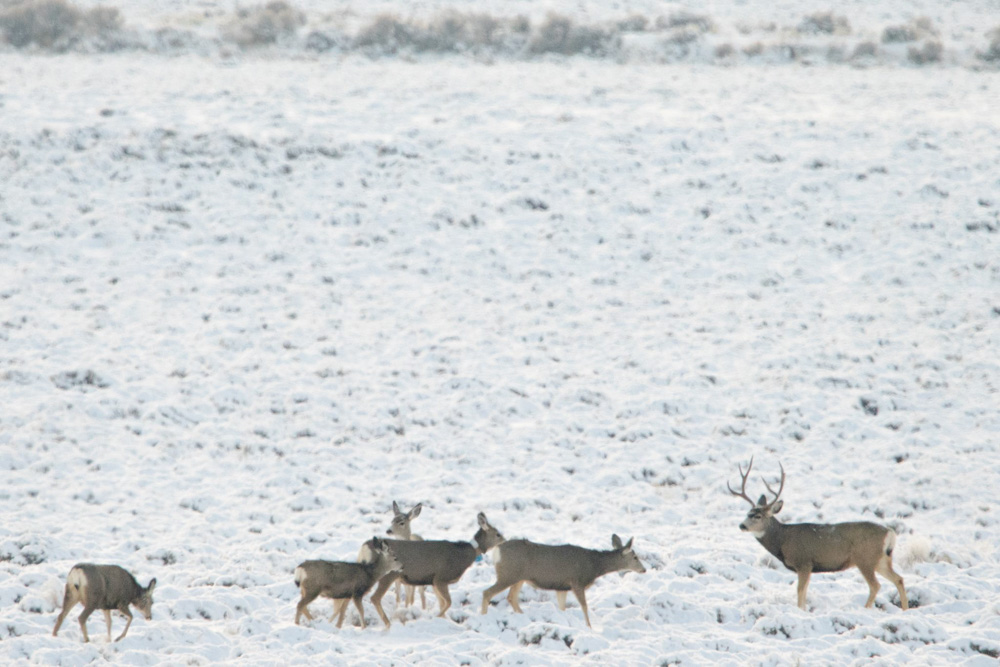Below is a news release from the University of Wyoming.
Diseases affect survival and reproduction in wildlife, but documenting the influence of diseases on evolution in wild populations is challenging. A group of University of Wyoming researchers presents evidence that chronic wasting disease is driving evolution in mule deer.
Holly Ernest, a UW professor of wildlife genomics and disease ecology, was part of a research group that examined a single genetic mutation tied to slowing the progression of chronic wasting disease in mule deer.
“We collected samples from mule deer throughout Wyoming, where chronic wasting disease has gradually spread over the past several decades,” says Ernest, the Wyoming Excellence Chair in Disease Ecology in the Department of Veterinary Sciences and the Program in Ecology. “Using this variation in space and time, we found that a single genetic mutation linked to slower disease progression has become more common over time and that individuals with the slow mutation were less likely to test chronic wasting disease-positive, providing evidence of disease-driven evolution in mule deer.”
Ernest is senior and corresponding author of a paper, titled “Spatio-temporal Analyses Reveal Infectious Disease-Driven Selection in a Free-Ranging Ungulate,” that was published today (Aug. 11) in Royal Society Open Science. The open journal publishes high-quality research across all of science, engineering and mathematics.
The lead author of the paper is Melanie LaCava, a recent UW Ph.D. graduate in the Program in Ecology and Department of Veterinary Sciences. This study was part of LaCava’s dissertation research.
Other UW contributors to the paper were Jennifer Malmberg, a UW assistant professor of veterinary sciences, and Laura Johnson, an associate research scientist in veterinary sciences. Hank Edwards, wildlife health laboratory supervisor, and Samantha Allen, a veterinarian, both of the Wyoming Game and Fish Department, also contributed to the paper.
Chronic wasting disease is caused by infectious proteins, or prions, that are spread among animals in the deer family. The abnormal structure and buildup of infectious proteins cause neurological disease that virtually always progresses to death in deer and their relatives, including elk. Earlier studies have indicated that specific variants within a gene that mammals have, called the prion protein gene, or PRNP for short, are associated with either rapid onset or delayed progression of fatal disease.
Since its discovery in northern Colorado in the 1960s, chronic wasting disease has expanded its range in North America and has spread to northern Europe and southeast Asia. Chronic wasting disease has contributed to population declines in mule deer and white-tailed deer. In Wyoming, chronic wasting disease was first documented in 1985 and has gradually spread across mule deer populations, producing natural variation in disease history to evaluate selection pressure.
Infectious diseases play an important role in wildlife population dynamics by altering individual fitness, but detecting disease-driven natural selection in free-ranging populations is difficult due to complex disease-host relationships.
The UW-led study expanded on previous research by analyzing spatiotemporal patterns of individual- and herd-based disease data to present multiple lines of evidence for disease-driven selection in free-ranging wildlife, Ernest says.
“We used spatial variation and a novel temporal comparison to investigate the relationship between chronic wasting disease and a mutation at codon 225 of the mule deer prion protein gene that slows disease progression,” Ernest explains. “We found that individuals with the ‘slow’ 225F allele were less likely to test positive for chronic wasting disease, and the 225F allele was more common in herds exposed to chronic wasting disease longer. We also found that, in the past two decades, the 225F allele frequency increased more in herds with higher chronic wasting disease prevalence.”
Previous research shows that when a 225F deer contracts chronic wasting disease, the entire progression of the disease will take longer than it does in deer without the 225F allele, LaCava says.
“In the early stages of chronic wasting disease, this means that 225F deer take longer to accumulate detectable levels of chronic wasting disease. So, it is possible that some deer that tested negative for chronic wasting disease in our study were exposed to chronic wasting disease already, but the disease had not progressed enough to be detectable,” LaCava says. “The relationship we observed between the 225F allele and chronic wasting disease status aligns with previous research, providing further evidence of slower disease progression in 225F mule deer.”
Documenting this relationship between chronic wasting disease, a disease causing population declines, and the 225F allele, a mutation that slows disease progression, adds important information to understanding and managing chronic wasting disease in mule deer, LaCava says.
“If 225F deer have more opportunities to reproduce before dying of chronic wasting disease, and if the 225F allele is becoming more common, then this could alter our expectations about future population declines caused by chronic wasting disease,” LaCava says. “For example, if the 225F allele continues increasing, maybe deer will produce more offspring before dying, and population decline will be less extreme. In contrast, if 225F deer live longer, they could spread chronic wasting disease more than deer that die sooner, so an increase in the 225F allele could actually lead to more disease spread and, therefore, more population declines.”
While it remains unclear whether selection favoring the 225F allele will benefit mule deer populations in the long term, documenting this evidence for selection is an important part of understanding disease dynamics. Future work can now incorporate selection acting on the 225F allele into models to better predict future population dynamics.
“A question puzzling wildlife managers and researchers involves how the spread of infectious diseases, including chronic wasting disease in populations, affects genetics and evolutionary processes of the animals,” Ernest says. “Understanding these processes and outcomes is essential for effective management and conservation of natural populations.”
The research was supported by the Wyoming Governor’s Big Game License Coalition, the Carlton R. Barkhurst Dissertation Fellowship, the UW Program in Ecology, the Riverbend Endowment in Wildlife-Livestock Health and funding through the Wyoming Excellence Chair fund.
(Photo source: Wyoming Game and Fish Department)
